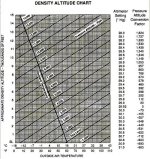DA and Centerfire
Many are concerned about how to accurately and inexpensively determine density altitude. As I explained in a previous post, you can make perfect use of your tuner knowing little or nothing about DA if you are willing to sacrifice two or three more sighters each time you go to the line. I frequently make use of the old reliable technique known as the "TLAR" method. That's right,, TLAR is an acronymn that means, "That looks about right."


Works gooooooood!

As explained in part 2 of, "How to use a tuner" it is not necessary to know DA for the first match of the day. By using the simple procedure described there you can quickly get your rifle in tune, and if you wish to make use of a formula for future adjustments that day, make a note of the DA and tuner setting. Then you can accurately predict what the new setting will be when the DA goes up, 250', 500', and so on. But if you do not want to fool with DA, you can simply repeat the procedure described in part 2 each time you go to the line.
Normally, from the cool of the morning to the heat of the afternoon, temperature increases incrementaly by about 20 to 25 degrees, so you know that as the day progresses, you will have to turn the tuner IN about one eighth of a turn for each 5 degrees increase in temperature. It's really not that hard at all, let me ask you this.
Your scope has a focus ring/knob that must be adjusted to get the sharpest sight picture each day; does it not? And although it could probably be determined with a computer program what the actual number would be on the dial at certain temperatures, you don't worry about the numbers; do you? Of course not, and the same thing applies to a tuner. You simply adjust the tuner until you have the rifle "IN FOCUS."

Sure,,, if it was in tune an hour ago when the temperature was 70 degrees and the temp is now 75, you know it can't be off very far; huh? Sure, you know the DA has gone up a little, but not much and you do not have to start all over again. Turn the tuner IN an eighth of a turn and fire a couple or three sighters.
Hope this helps simplify things. In previous posts, I explained how and why changes in DA affect tune, and went into such detail mainly to help you understand what was going on, but you can make good use of your tuner just by using common sense. It's not hard.

Later,,
Gene Beggs


